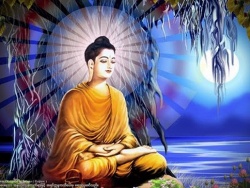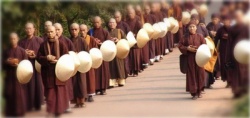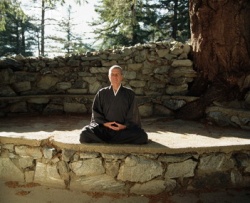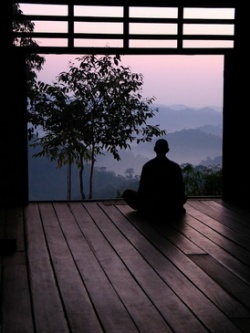Living Two Traditions
Gil Fronsdal has been a student of Buddhist practice for more than twenty-five years. He trained in the Soto Zen tradition, receiving dharma transmission in 1995, as well as in the Vipassana-or Insight Meditation-lineages of Theravada Buddhism. Since 1990, Fronsdal has served as resident teacher at the Insight Meditation Center of the Mid-Peninsula in Redwood City, California. Only the second urban Insight Meditation center in America, it is funded entirely by dana contributions. Tricycle Editor-in-Chief James Shaheen interviewed Gil Fronsdal at his center in August 2002.
The last thirty years has seen an exponential growth of the Western Vipassana community. As every indication is that this will continue, what developments can we expect over the next ten years?
It is unusual for someone to be a teacher of both Zen and Vipassana. Since you started out in the Zen tradition, can you describe how you first came to the practice? My interest in Buddhism began in college while I was studying environmental science. I was thinking about how to respond to environmental degradation, and how to understand our contribution to this problem. That led me through a series of steps to Eastern thought-Chinese thought, Taoism, and a whole different paradigm for our relationship to nature. 1 began reading Alan Watts’s work and other books on Buddhism, and I was inspired because they seemed to offer new answers. Then a year or so later I was introduced to Suzuki Roshi’s Zen Mind, Beginner’s Mind, and I was really taken by it. It was as if it articulated a view of life that I myself had held without realizing it. I was also interested in its emphasis on meditation, although by then I had dropped out of college and was living in a spiritual community where there was almost no sitting.
Which community?
The Farm in Tennessee. The Farm was a commune of some eight hundred people founded by Stephen Gaskin and others who came out of the spiritually inclined, acid-taking circles of 1960s San Francisco Hippiedom. I had been interested in living and farming on a rural commune. In 1975, on a cross-country trip, I stopped by the Farm for what was to be a couple of days and ended up staying. I had no interest in spiritual practice whatsoever, so I was surprised to find how delighted 1 was to be there. The people at the Farm considered honesty one of their primary spiritual practices. They looked at it as a substitute for LSD because they thought it had equal transformative power. They had developed very powerful skills of talking with one another, clarifying what was really happening between people. It was there that I discovered Zen Mind, Beginner’s Mind, which seemed to be their bible. But they didn’t meditate. So, the first chance I had, I went to San Francisco Zen Center, founded by Suzuki Roshi. There I discovered zazen, or Zen-style sitting meditation. I loved zazen practice, and I threw myself into it. Slowly I became interested in bringing the mind of zazen into my daily life. I ordained as a priest, going deeper and deeper into the world of Buddhist practice.
How did you begin practicing Vipassana?
After seven years of Zen practice in the West, I continued my training in a Zen monastery in Japan. While there, I had to leave the country to renew my visa. I traveled to Thailand, and while I waited for the new visa, I went to a meditation monastery outside Bangkok. Curious about how meditation was done in the Theravada tradition, I followed the abbot’s instructions-which happened to be for an intensive period of Vipassana practice. Since it took ten weeks to clarify my visa situation, my first silent Vipassana retreat was ten weeks long. With the strong concentration of that retreat, I touched what I can only describe as some core element of my mind, which I felt compelled to pursue further. A year later, I returned to Thailand and Burma for about a year and a half of intensive Vipassana training.
How was it to practice Vipassana after years of Zen training?
The core of Vipassana is mindfulness, or the practice of being clearly present to what is happening in the present. In a sense it is a tool that can be practiced within a variety of practice approaches. The context for the Vipassana teaching I encountered in Asia was one of being goal-oriented. U Pandita, my Burmese teacher, was adamant about striving for nirvana, for deep insights and attainments. If I had been a new meditator, I wouldn’t have survived in that kind of environment. I would’ve gotten tied up in ambition and self-judgment. But in my Zen practice I had been practicing a radical acceptance of the present moment for many years. I was pretty resilient and not easily discouraged. While I tried to follow the Vipassana instructions as best I could, at the same time I saw how helpful they were for me to be more thorough in the Zen practice of shikautaza-just sitting.
Did working within the two different traditions bring up any conflicts for you?
I struggled a fair amount, trying to reconcile goal-less Zen practice-in which practice and realization are thought to occur together-with the goal-oriented Theravada tradition, in which you work toward later realization. Eventually I came to understand that these approaches not only complemented each other but could be seen as two sides of the same coin. Soto Zen taught me to emphasize the purity of the moment-to-moment process of sitting in meditation; Vipassana taught me how that process opens to greater freedom even when we don’t fixate on freedom as a goal. My Vipassana practice taught me that the radical acceptance of myself and of things-as-they-are that I learned in Zen included an innate, natural impulse toward liberation. I didn’t have to be goal-oriented as much as I needed to let go of any obstacles to this innate impulse. One of the hindrances I had faced in Zen practice was complacency-a comfort-able, lightweight acceptance-in which I lacked the motivation to see the ways in which I was still subtly attached or resistant to reality. Vipassana, especially with its emphasis on seeing clearly what is happening in the present, helped break me out of my complacent state.
Do you bring Zen elements into your Vipassana teachings?
From the Zen tradition I emphasize that each moment of sincere mindfulness practice is complete and satisfying in and of itself. I encourage practitioners to investigate what gets in the way of realizing this. I teach that the goal should be reflected in the means, in the practice. If the goal is to be at peace, some form of peacefulness should be a part of the practice. To become compassionate, practice compassion. To be generous, practice generosity. To be free, don’t let the practice or attainments be objects of grasping.
Were there elements of the Vipassana tradition that you felt in conflict with?
I grappled some with the Theravadan teaching of the three characteristics: impermanence, suffering, and no-self. When I was in Thailand and Burma, I was struck by the way this teaching served as the dogmatic foundation of nearly every dharma talk; I was a little put off by how, over and over again, we heard about the three characteristics. It seemed like a dogma or a view that people adopted not because they had insight into the three characteristics but because it was what they were told. I was mistrustful of adopting a view about life as opposed to cultivating insight.
Do you mean applying a view without fully under-standing it?
I mean that insight is not a view. Because of my Zen background, I have a certain distrust of views; Zen practice is in part one of pulling the rug out from under any view we apply to our experience.
So what was your problem with the teachings on the three characteristics?
I couldn’t quite wrap my mind around them. Sure, in some ways everything’s impermanent. The mountains are impermanent-that I could accept. But that the mountains were suffering seemed a little odd co me. And that the mountains were “not-self’ also had little meaning for me. The teaching that everything was impermanent made sense logically but remained, somehow, only a view without much personal meaning.
Eventually, I decided that I could only understand the three characteristics as describing the nature of’ how I experienced the world. There are lots of problems in claiming to know what reality actually is, what it is like. I don’t see Buddhism as a form of physics. Rather, I saw mindfulness as revealing how I perceive the world.
Then what is the value of the three characteristics?
As Vipassana practice deepens, the three characteristics become obvious. They are not a view, or an understanding that we apply; they become clear and predominant experiences. It’s very direct and immediate. And the greatest value of these insights is that they are powerful aids in helping the mind loosen its clinging. When we can find nothing permanent to grasp onto, the mind will eventually stop grasping.
Can you say more about view versus insight?
During my college education, I had come to recognize my own tendency to cling to views without testing them against experience or evidence to the contrary. As an undergraduate at UC Davis, I majored in agronomy, the art and science of field crop management. As an ardent environmentalist, I had a lot of views about organic farming and conventional farming. But as 1 studied the science of soils, crops, and fertilizers, I realized that some of my views were simplistic generalizations. Some of them just weren’t true, and yet I’d been holding on to them tenaciously. I was really humbled by this. So when I came to Buddhism, especially when I started an academic study of Buddhism in graduate school at Stanford, I was keenly interested in not falling into the same trap. I was aware that people involved in religion tend to generalize quite readily. I wanted to be on the lookout against doing the same thing again.
How did you manage that?
My interest in the academic study of Buddhism intellectually liberating. It helped me understand much more clearly what views I held, where I made generalizations, what assumptions underlay them. On what authority did I rake something to be true? Some of my questioning came from my Zen training, where in a sense the idea was to abide with no views at all. When I work with students, I try to get at what view they are holding. Is it appropriate? Can I pull the rug out from under them in an appropriate way?
But sometimes you have a less demanding approach. You’ve summarized the Four Noble Truths by writing, “There is happiness and there are causes for happiness.” Why that reformulation? Is it a bit too soft?
That formulation is not meant as a definitive explanation of the Four Noble Truths, but I find that people can get too serious about Buddhist practice. A little dour sometimes. They’re looking at their attachments, their grasping, and how to let go, and their practice becomes heavy. If you can remember that happiness and joy are a part of the goal, you’re less likely to fall into that trap. And the practice becomes more approachable, too.
Nowadays, everyone from corporate executives to sports figures finds mindfulness practice-or the practice of Insight Meditation-useful and, to use your word, approachable. Often the word Buddhism is eliminated from the teaching of the practice altogether. Do you see any danger in that? For example, what is to stop mindfulness practice from simply becoming a tool for a CEO who is, say, intent upon running a more profitable organization rather than a more ethical or compassionate one?
I’m not sure how to answer that, but let me take it from this angle: I think that Vipassana practice and mindfulness practice are very powerful and helpful. I’m happy to see them help people however they can. Lots of people are not interested in Buddhism or in following the Eightfold Path. I don’t feel a need to convert them. \What I’m trying to do here at our center is to make Buddhist practices available to the widest range of people possible, and to address a broad range of interests and needs.
My attitude comes from the bodhisattva spirit I learned as a Zen practitioner: a vow to alleviate suffering. I’m not going to turn away from anybody who comes in wanting the kind of help that we can offer: instruction in meditation and the dharma, a place to sit, and a community to practice with. Some people are devoting their entire lives to Buddhist practice. They are doing lots of long retreats, even going off to Asia to become nuns and monks. That’s one end of the spectrum, and it’s important for me that our center supports them. At the other end of the spectrum are people who walk in off the street. They have stressful lives, they have a hard time coping, and they stumble upon our center. I’m happy that we can offer skills that help them. They don’t have to become Buddhists. If what they want is to cope better, I’ll try to help. I try to meet them where they are.
People can complain about “Buddhism lite,” but I trust the practice. I have a lot of faith in people’s hearts. I believe that inherent in each person is a momentum toward liberation and greater compassion. And if you help people in appropriate ways, that’s what wants to come out. I don’t have to proselytize or encourage people to move in any particular direction. It’s best just to meet people where they are. If practice is too self-centered, sooner or later they will either stop practicing or understand the limitations of being self-centered. After a certain point, it is not possible to continue practicing just for yourself. The motivation to keep going comes in part from caring for others, also.
You mentioned that you’re returning to some of the more traditional aspects of practice, sutta practice, for instance. Are there other more traditional practices you’re bringing to teaching Vipassana at your center?
Yes. I am currently teaching a class on the Pali suttas. Every couple of years I teach a class and conduct a ceremony for people interested in formally taking refuge in the Buddha, the Dharma, and the Sangha. I’d like to include more chanting and traditional Buddhist festivals, but we haven’t done much of either so far, with the exception of our annual Vesak festival, celebrating the birth of the Buddha. I have also started to invite Theravadan monastics to be more part of our community as visiting teachers.
What would a traditional practice like chanting bring to your sangha?
Chanting both invokes and expresses people’s faith in practice, and the inspiration that comes with faith. Some people chant to aid in concentration. But mostly I see it providing a heartfelt connection to the lineage, the Buddha, the Dharma, and the Sangha. For some people that’s very valuable. And, aside from faith and concentration, chanting-if you understand what you’re chanting-has a powerful effect on the psyche. The chanting voice can awaken the meditative mind, allowing the words and their meaning to sink in quite deep.
I guess this raises the question of whether some-thing is missing from the practice of Vipassana with-out some of the more traditional Buddhist rituals. Can you say something about that?
Ritual is helpful in better integrating our lives, as well as in building a community that supports practice. It’s very hard to practice Buddhism, especially all the way to enlightenment. A community can help us integrate our Buddhist practice with all aspects of our lives.
Does this make you wonder about beginning with Vipassana meditation rather than with more fundamental practices and rituals first?
There is nothing inherently wrong with beginning with Vipassana practice. However, it can be very difficult to sustain over a long period of time without support. Traditionally, Vipassana is practiced with the firm sup-port of ethics, community, rituals, and inner practices like loving-kindness and concentration. Some of these other Theravadan practices like festivals and rituals function to bring a community together to form a sup-port for practice, and to remind us that practice is not just something we do for ourselves. I would say that a minor shortcoming of the American Vipassana movement is that it hasn’t cultivated sangha as strongly as it could, leading to a tendency for some practitioners to be overly self-focused in the practice. Community practices and traditions can help remedy that shortcoming.
You talk about community a lot, and your center is situated right on the border between middle-class and working-class residential neighborhoods. What is your involvement with the neighborhood?
We’re a new community meditation center, and we’re crying to be responsive to our community. Our doors are open to the community at large. I like to think of the seven exterior doors to this building as symbolizing that we welcome people co come and go, without any barriers. People can wander in and participate in what-ever way works best for them. That we work on a dana, or donation, basis only-people give what they can and when they like-removes another barrier. People have told me how comfortable they felt when they first came here-that it was the only public group they knew of where they could come without having anything asked of them, and practice at the level that suited them.
As a community center, do you offer children’s programs?
Yes, and it’s been interesting and fun. At some children’s programs, I’ve taught the precepts, but I call them the Five Protections. I say, “‘This is what protects you.” And I might talk also about how these five precepts protect our families and our community. I once explained to the children that when you’re first born, you can do nothing for yourself; your parents do every-thing for you. And then slowly, as you get older, you to do more and more for yourself, and your parents are there less and less to protect you, and when you’re an adult, you eventually leave to live your own life. But you can always carry these Five Protections with you.
The way you’re describing the center and its development, it sounds like you’re describing a work in progress. Is that how you see it?
The whole Vipassana movement is a work in progress. It’s an experiment. That’s why I find it very useful to study the traditional Asian Buddhist teachings, practices, and worldviews-not necessarily to adopt them wholesale here in the West, but to highlight what we’re doing that is not traditionally Buddhist. That way we can be more responsible about what we adopt and how we innovate. I don’t have any problem with innovation, but I think it’s important to be conscious of the assumptions underlying what we are doing when we innovate, and why.
Can you give me an example of an innovation, and whether you think it’s a helpful one?
One example is the way the American Vipassana movement emphasizes interconnectedness when teaching anatta, or “not-self.” This is emphasized so much that a person might get the idea that realizing interconnectedness is the ultimate goal of Buddhism. It’s not; this is a very American emphasis. I think interconnectedness is inspiring to us as an antidote to American individualism and the pain of alienation it can cause. For many traditional Asian Buddhists, especially in Indian and Southeast Asia, these teachings on interconnectedness would be unfamiliar. They may not even be useful because in Asia lack of connectedness is generally not the problem that it is in the West. In the Pali discourses of the Buddha, interconnectedness is not seen as of ultimate value; liberation is not contingent on the interconnected world. So here’s where understanding the Asian tradition and worldview helps expose a difference in the teachings in the West. Once we see that difference, we can ask ourselves why we are teaching differently. What’s the meaning of emphasizing interconnectedness? Why is it so important? We can also ask how the American emphasis aligns with core Buddhist teachings. People will give a variety of answers. Some say the emphasis on interconnectedness is a deviation from the dharma; others, an improvement on the dharma. Another view is that it is simply an accurate translation of the dharma appropriate for our culture. Or it may highlight aspects of the teachings that are in the back-ground in Asia. I am not particularly interested in settling on one of these views; they may all have some truth to them. I am interested in understanding the Asian tradition so we won’t fool ourselves into thinking that what we’re teaching is how Buddhism has always been taught.
If you posit this notion of an interconnected self, shouldn’t that interconnected self come under the same Buddhist scrutiny that the individual self has?
I would hope so. To conclude that the self is one with the universe or that there is a “nonseparate self’ is still a view of self. It is all too easy for people to take a pro-found experience as the goal of the path or to relate the experience to some concept of self. The feeling of inter-connectedness with all life is very powerful. But if a person thinks that’s it-I’ve reached the final goal-they’re shortchanging themselves, because liberation is beyond conditioned experience. Meditative or mystical experiences of interconnectedness may be one of the most wonderful conditioned experiences, a pinnacle of conditioned life, but it’s still conditioned.
A challenging aspect of traditional Buddhist teachings is that any view that we hold about the nature of self, whether an independent or an interdependent self, falls short of full liberation; it’s just an idea. So I emphasize the power of mindfulness practice, nondiscursive penetration rather than reflective consideration. Nondiscursive mindfulness practice has a lot to do with mindfulness of the body, with direct experience.
Are you optimistic about the future of Buddhism in America?
Oh, yes. I’m very optimistic when I think of the growing community of dedicated practitioners. I am also enthusiastic about the ways in which many practitioners from different traditions are learning from each other. At the same time, as we learn from each other-which is such a big part of the American tradition-I hope we’ll keep the traditions distinct from one another. I’m a Zen teacher and a Vipassana teacher, and I think it very important not to blur the two traditions and make them the same. Each is unique. They come out of different worldviews. They have different understandings and approaches to the dharma. I don’t want American Buddhism to be just a melting pot. I like to see the traditions existing together harmoniously, serving as mirrors to each other, helping practitioners plumb the depths of their own traditions.
But you’re a perfect example of a Westerner who has been exposed to more than one tradition. Won’t the traditions naturally influence and shape each other?
I’m happy with the mixed influence, but I wouldn’t want the traditions themselves to merge into an indistinct form. One of the blessings and curses of being a teacher in two traditions is that I want to be careful about maintaining the difference. Someone who is in only one tradition can borrow and adapt from the other traditions without worry. But I need to be a little more concerned because I don’t want simply to turn Vipassana into a different form of Zen or Zen into a different form of Vipassana. There are differences, and I respect those differences, and I’m grateful to have been enriched by both.






